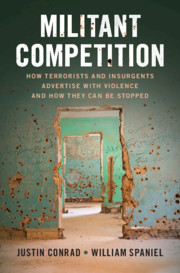
- Cited by 3
-
Cited byCrossref Citations
This Book has been cited by the following publications. This list is generated based on data provided by Crossref.
Polo, Sara M.T. and Welsh, Blair 2024. Violent Competition and Terrorist Restraint. International Organization, Vol. 78, Issue. 3, p. 397.
Coe, Andrew J. Schram, Peter and Yoo, Heesun 2024. Terrorism Works, for its Supporters. Journal of Conflict Resolution,
Conrad, Justin Greene, Kevin T. and Phillips, Brian J. 2024. Introducing ViNSAR: Dyadic Data on Violent Non-State Actor Rivalry. Journal of Conflict Resolution, Vol. 68, Issue. 9, p. 1884.
- Publisher:
- Cambridge University Press
- Online publication date:
- September 2021
- Print publication year:
- 2021
- Online ISBN:
- 9781108992275


